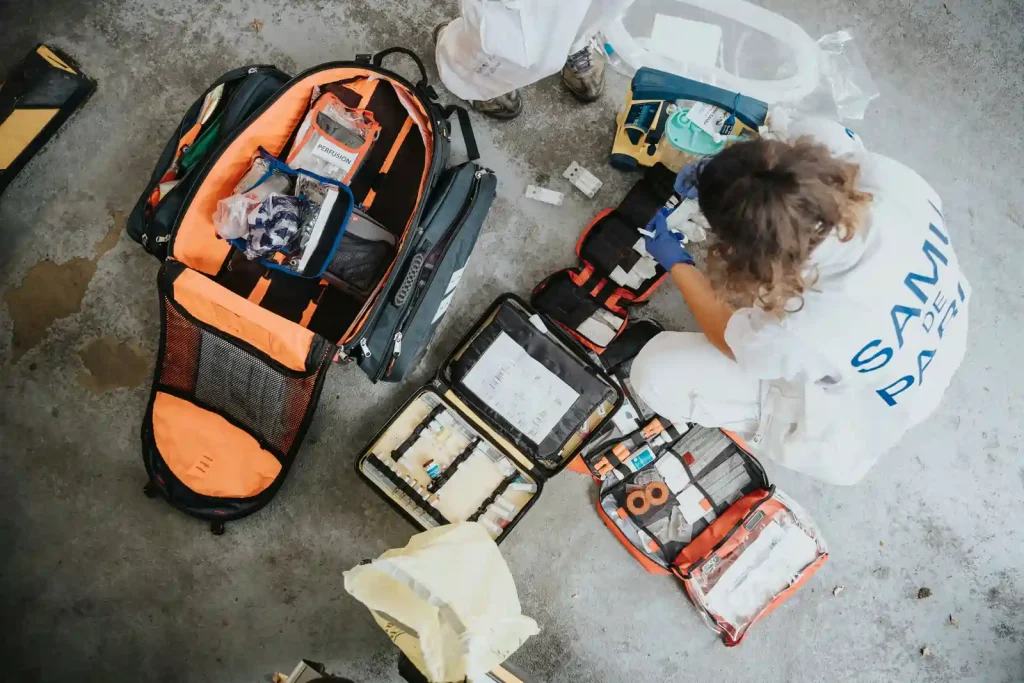Ambulance costs in Switzerland can be surprisingly high, yet a ride to the hospital is often life-saving. What many people don’t realize is that a single ride can cost anywhere from a few hundred to a few thousand francs. Basic health insurance (KVG / LAMal) pays back only part of that bill, so—unless you have extra coverage—you may still have to pay a large share yourself.
Typical Prices for an Ambulance in Switzerland
For a 50-kilometer journey, ambulance costs in Switzerland range from about CHF 1’000 in cantons that subsidize rescue services (for example, Aargau) to around CHF 2’150 in cantons that charge the full cost to patients (for example, St. Gallen). Most cantons fall in the CHF 1’500–1’600 band—Zurich averages CHF 1’500 and Lucerne CHF 1’560. If you compare these numbers across regions, you’ll notice that ambulance costs in Switzerland are generally higher in rural areas, in which no subsidies apply (Kägi, SRF).
Who Pays the Bill for the Ambulance?
Whether insurance covers ambulance costs in Switzerland depends on two key questions:
- Was the ambulance needed because of an accident or because of an illness?
- If it was an accident, do you work at least eight hours a week for the same employer?
If the Call-out Was After an Accident
You work ≥ 8 hours per week for one employer – You are automatically insured under the Accident Insurance Act (UVG / LAA). The accident insurer pays the ambulance costs; you do not need to pay a deductible or a co-payment. In this scenario, ambulance cost in Switzerland is effectively zero, because UVG covers it fully.
You work < 8 hours per week or you are self-employed without UVG cover – in this case, accident costs are covered under your basic health insurance (LAMal) and treated the same way as an illness (see next section).
Important: For accidents abroad, UVG / LAA will pay up to CHF 29’640. Anything beyond that—and every illness-related rescue abroad—requires supplementary insurance. In practice, that can push the total ambulance cost in Switzerland (if the incident happened abroad) to tens of thousands of francs before UVG extras apply.
If the Call-out Was Due to an Illness
Basic health insurance (LAMal) shares the cost with you, but only up to certain limits:
It refunds 50 % of the bill, but only up to two yearly limits:
- CHF 500 in total for medical transports (situations that are not immediately life-threatening).
- CHF 5’000 in total for rescues (life-threatening situations) carried out inside Switzerland.
Before LAMal pays anything, you must first reach your annual deductible (Franchise), which can range between CHF 300 and CHF 2’500. After that, you still pay a 10 % co-payment on every medical bill until you hit the annual co-payment cap (CHF 700 for adults). In other words, in a non-life-threatening situation your total out-of-pocket ambulance cost in Switzerland can easily exceed CHF 800.
Important: LAMal does not cover illness-related rescues that happen outside Switzerland. That is when a supplementary travel or international health insurance plan can save you from extremely high ambulance costs in Switzerland after an overseas emergency.

Example 1 – Heart-attack Rescue (Life-threatening)
Ambulance bill: CHF 3’000
Your deductible (Franchise): CHF 2’500 — you did not have any medical bills this year, so the deductible is still completely open. In this case, your net ambulance cost in Switzerland will depend on how much of that CHF 3’000 goes toward your franchise.
What happens:
- Basic insurance covers 50 % for rescues (up to CHF 5 000 per year).
- 50 % of CHF 3’000 = CHF 1’500 — this is what LAMal would cover.
- BUT — because your deductible is CHF 2’500 and you haven’t used it — this CHF 1’500 goes toward that deductible (so no refund yet).
Result: You pay the full CHF 3’000 out-of-pocket. Effectively, your ambulance cost in Switzerland for this heart-attack scenario will be CHF 3’000, since CHF 1’500 is not covered and CHF 1’500 goes to your franchise.
Example 2 – Dialysis Transport (Non-Life-threatening)
Ambulance bill: CHF 800
Your deductible (Franchise): CHF 2’500 — you did not have any medical bills this year, so the deductible is still completely open. This means the ambulance cost in Switzerland for a routine dialysis run hits your deductible first.
What happens:
- Basic insurance covers 50 % for medical transports (up to CHF 500 per year).
- 50 % of CHF 800 = CHF 400 — this is what LAMal would cover.
- BUT — because your deductible is CHF 2 500 and you haven’t used it — this CHF 400 goes toward that deductible (so no refund yet).
Result: You pay the full CHF 800 now. In other words, your ambulance cost in Switzerland for this dialysis run is CHF 800, since CHF 400 is not covered and CHF 400 goes to your deductible.
With a supplementary health insurance product, you could avoid these out-of-pocket costs, saving CHF 1’500 in the heart-attack case or CHF 400 in the dialysis transport case. That’s a major reduction in total ambulance cost in Switzerland.
When Insurers Refuse to Pay?
Both health and accident insurers can reject claims they view as medically unnecessary. For example, if you could safely have travelled by private car or public transport. Even in those cases, you may still face a nominal ambulance cost in Switzerland if the insurer deems the ride unnecessary.
Why Take Supplementary Insurance?
A supplementary outpatient insurance policy can fill these gaps by covering 100 % of ambulance and rescue costs, both in Switzerland and abroad. That way, you avoid any ambulance cost in Switzerland that KVG/LAMal won’t cover.
Premiums usually start from around CHF 10 per month, depending on your age, canton of residence and the level of coverage you choose. When you compare plans, be sure to check how they handle ambulance costs in Switzerland versus abroad.
In addition, most of these products include other useful benefits, such as:
- Coverage for alternative treatments
- Coverage for extra medications
- Coverage for preventive care
- Room upgrades during hospital stays
So for a reasonable price, you can combine full emergency transport cover with a wider package of health-related services.
If you would like more detailed information or personalized support to review your insurance and find the best products, visit our contact form—we’re here to help you navigate your options.



